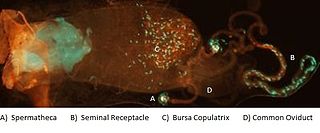Related Research Articles

The migratory locust is the most widespread locust species, and the only species in the genus Locusta. It occurs throughout Africa, Asia, Australia and New Zealand. It used to be common in Europe but has now become rare there. Because of the vast geographic area it occupies, which comprises many different ecological zones, numerous subspecies have been described. However, not all experts agree on the validity of some of these subspecies.

Octopamine (molecular formula C8H11NO2; also known as OA, and also norsynephrine, para-octopamine and others) is an organic chemical closely related to norepinephrine, and synthesized biologically by a homologous pathway. Octopamine is often considered the major "fight-or-flight" neurohormone of invertebrates. Its name is derived from the fact that it was first identified in the salivary glands of the octopus.
Odorant-binding proteins (OBPs) are small soluble proteins secreted by auxiliary cells surrounding olfactory receptor neurons, including the nasal mucus of many vertebrate species and in the sensillar lymph of chemosensory sensilla of insects. OBPs are characterized by a specific protein domain that comprises six α-helices joined by three disulfide bonds. Although the function of the OBPs as a whole is not well established, it is believed that they act as odorant transporters, delivering the odorant molecules to olfactory receptors in the cell membrane of sensory neurons.

The miR-9 microRNA, is a short non-coding RNA gene involved in gene regulation. The mature ~21nt miRNAs are processed from hairpin precursor sequences by the Dicer enzyme. The dominant mature miRNA sequence is processed from the 5' arm of the mir-9 precursor, and from the 3' arm of the mir-79 precursor. The mature products are thought to have regulatory roles through complementarity to mRNA. In vertebrates, miR-9 is highly expressed in the brain, and is suggested to regulate neuronal differentiation. A number of specific targets of miR-9 have been proposed, including the transcription factor REST and its partner CoREST.

Galactoside 2-alpha-L-fucosyltransferase 1 is an enzyme that in humans is encoded by the FUT1 gene.
Crustacean cardioactive peptide (CCAP) is a highly conserved, amidated cyclic nonapeptide with the primary structure PFCNAFTGC-NH2 (ProPheCysAsnAlaPheTyrGlyCys-NH2) and a disulfide bridge between Cys3 and Cys9. It is found in crustaceans and insects where it behaves as a cardioaccelerator, neuropeptide transmitter for other areas of the nervous system and a hormone. CCAP was first isolated from the pericardial organs of the shore crab Carcinus maenas, where it has a role in regulating heartbeat. It was assumed that this was the peptide's main function and its name reflects this.
Corazonin is a highly conserved neuropeptide found in many insects, in particular locusts and cockroaches.
Bursicon is an insect hormone which mediates tanning in the cuticle of adult flies.

The halloween genes are a set of genes identified in Drosophila melanogaster that influence embryonic development. All of the genes code for cytochrome P450 enzymes in the ecdysteroidogenic pathway (biosynthesis of ecdysone from cholesterol). Ecdysteroids such as 20-hydroxyecdysone and ecdysone influence many of the morphological, physiological, biochemical changes that occur during molting in insects.

Female sperm storage is a biological process and often a type of sexual selection in which sperm cells transferred to a female during mating are temporarily retained within a specific part of the reproductive tract before the oocyte, or egg, is fertilized. This process takes place in some species of animals, but not in humans. The site of storage is variable among different animal taxa and ranges from structures that appear to function solely for sperm retention, such as insect spermatheca and bird sperm storage tubules, to more general regions of the reproductive tract enriched with receptors to which sperm associate before fertilization, such as the caudal portion of the cow oviduct containing sperm-associating annexins. Female sperm storage is an integral stage in the reproductive process for many animals with internal fertilization. It has several documented biological functions including:
In molecular biology mir-277 microRNA is a short RNA molecule. MicroRNAs function to regulate the expression levels of other genes by several mechanisms.

The Qiupa Formation is a Late Cretaceous Maastrichtian geologic formation in Henan Province, central China. It is rich in dinosaur eggs and bones, such as those of carnivorous and herbivorous dinosaurs. The Qiupa Formation is considered to be Late Maastrichtian in age, about 72 million and 66 million years ago.

Li Jiayang is a Chinese agronomist and geneticist. He is Vice Minister of Agriculture in China and President of the Chinese Academy of Agricultural Sciences (CAAS). He is also Professor and Principal investigator at the Institute of Genetics and Development at the Chinese Academy of Sciences (CAS).

Chuan He is a Chinese-American chemical biologist. He currently serves as the John T. Wilson Distinguished Service Professor at the University of Chicago, and an Investigator of the Howard Hughes Medical Institute. He is best known for his work in discovering and deciphering reversible RNA methylation in post-transcriptional gene expression regulation. He was awarded the 2023 Wolf Prize in Chemistry for his work in discovering and deciphering reversible RNA methylation in post-transcriptional gene expression regulation in addition to his contributions to the invention of TAB-seq, a biochemical method that can map 5-hydroxymethylcytosine (5hmC) at base-resolution genome-wide, as well as hmC-Seal, a method that covalently labels 5hmC for its detection and profiling.

Drosomycin is an antifungal peptide from Drosophila melanogaster and was the first antifungal peptide isolated from insects. Drosomycin is induced by infection by the Toll signalling pathway, while expression in surface epithelia like the respiratory tract is instead controlled by the immune deficiency pathway (Imd). This means that drosomycin, alongside other antimicrobial peptides (AMPs) such as cecropins, diptericin, drosocin, metchnikowin and attacin, serves as a first line defence upon septic injury. However drosomycin is also expressed constitutively to a lesser extent in different tissues and throughout development.
Kang Zhang is a Chinese-American ophthalmologist specializing in ophthalmic genetics and aging processes in the eye. He is currently a Professor of the Faculty of Medicine at Macau University of Science and Technology. He was previously a Professor of Ophthalmology and the Founding Director of the Institute for Genomic Medicine at the University of California, San Diego. Zhang is particularly known for his work on lanosterol, stem cell research, gene editing, and artificial intelligence.
Cytochrome P450, family 9, also known as CYP9, is a cytochrome P450 family found in Insect genome, CYP9 and insect CYP6 family belong to the same clan as mammalian CYP3 and CYP5 families. The first gene identified in this family is the CYP9A1 from the Heliothis virescens, which is involved in thiodicarb insecticide resistance. Subfamily CYP9A in Lepidopteran play important roles in insecticide resistance, can metabolize esfenvalerate efficiently.
Cytochrome P450, family 6, also known as CYP6, is a cytochrome P450 family found in Insect genome. CYP6 and CYP9, another insect CYP family, belong to the same clan as mammalian CYP3 and CYP5 families.
Cytochrome P450, family 305, also known as CYP305, is an animal cytochrome P450 family found in insect genome. The first gene identified in this family is the CYP305A1 from the Drosophila melanogaster.

The femoral chordotonal organ is a group of mechanosensory neurons found in an insect leg that detects the movements and the position of the femur/tibia joint. It is thought to function as a proprioceptor that is critical for precise control of leg position by sending the information regarding the femur/tibia joint to the motor circuits in the ventral nerve cord and the brain
References
- ↑ Wu L, Jia Q, Zhang X, Zhang X, Liu S, Park Y, Feyereisen R, Zhu KY, Ma E, Zhang J, Li S (October 2019). "CYP303A1 has a conserved function in adult eclosion in Locusta migratoria and Drosophila melanogaster". Insect Biochemistry and Molecular Biology. 113: 103210. doi:10.1016/j.ibmb.2019.103210. PMID 31422152. S2CID 201062949.
- ↑ Wu L, Yu Z, Jia Q, Zhang X, Ma E, Li S, Zhu KY, Feyereisen R, Zhang J (September 2020). "Knockdown of LmCYP303A1 alters cuticular hydrocarbon profiles and increases the susceptibility to desiccation and insecticides in Locusta migratoria". Pesticide Biochemistry and Physiology. 168: 104637. doi:10.1016/j.pestbp.2020.104637. PMID 32711771. S2CID 220797979.
- ↑ Wang Y, Wu L, Li H, Wen X, Ma E, Zhu K, Zhang J (June 2020). "The microRNA miR-184 regulates the CYP303A1 transcript level to control molting of Locusta migratoria". Insect Science. 28 (4): 941–951. doi:10.1111/1744-7917.12837. PMID 32524775. S2CID 219588137.